LEV is an extract ventilation system that takes dusts, mists, gases, vapour or fumes out of the air so that they can’t be breathed in. Properly designed LEV will:
- collect the air that contains the contaminants;
- make sure they are contained and taken away from people;
- clean the air (if necessary) and get rid of the contaminants safely.
The law says you must control the risks from hazardous substances (the Control of Substances Hazardous to Health Regulations (COSHH)). Installing LEV may help you to do this. However, beforehand, you should consider other options first where it’s reasonably practicable to do so, such as:
- change your method of work so exposure to hazardous substances can no longer occur;
- substitute the material being used by something safer;
- reduce the size of the source;
- modify the process to reduce the duration or frequency of emission;
- reduce the number of employees involved with a process;
- apply simple controls, e.g. fitting lids to equipment.
How do I make sure I get the right type of LEV?
There may be a standard, ‘off-the-shelf’ system that would be suitable. However, it should be fit for purpose and capable of adequately controlling exposure. Ask trade associations or check industry guides. For example: woodworking machinery manufacturers may be able to provide or recommend volume flow rates (VFR) for LEV systems fitted to their machines.
If changes to a standard system are required, or if there is no standard system for your industry, a clear specification will help get what’s needed, and avoid any misunderstandings with the LEV supplier. Get assistance to write a specification of what is needed.
Developing a specification for your LEV:
- describe the process, the contaminant, its hazards and the sources to be controlled, and how stringent the control needs to be. The important chemical and flammable properties of substances and products appear in the safety data sheet;
- require indicators to be fitted to show that the system is working properly;
- require the LEV to be easy to use, check, maintain and clean, taking account of other risks, eg accessibility, skin contamination and waste removal and filter changing without spreading contamination;
- specify that the supplier provides training in how to use, check and maintain the LEV system;
- require the supplier to provide a user manual that describes and explains the LEV system, how to use, check, maintain and test it, along with performance benchmarks and schedules for replacing parts;
- require the supplier to provide a logbook for the system to record the results of checks and maintenance.
Talking to employees and/or their representatives about how your LEV will be used can provide useful information to consider when drawing up your specification. This will help ensure the LEV is both effective and practical. Take this to an LEV supplier or to a ventilation engineer to design a system that will work.
Key documents to expect from the supplier
A user manual with a general specification of what the LEV system is designed to control and how it achieves that control, including:
- a description of the system with diagrams
- performance information from commissioning
- a description of checks and maintenance and replacement schedules, including frequency
- a listing of replaceable parts (and part numbers)
- a detailed description of the specific statutory ‘thorough examination and test’ requirements and exposure targets
- signs of wear and control failure
- a description of how operators should use the system so it works effectively.
A logbook that includes:
- schedules for regular checks and maintenance
- records of regular checks, maintenance, replacements and repairs
- checks of compliance with the correct way of working with the LEV system
- the name of the person who made these checks.
A commissioning report that includes:
- diagrams and a description of the LEV, including test points
- details of the LEV performance specification
- results, such as pressures and velocities at stated points
- calculations
- written descriptions of the commissioning, the tests undertaken and the outcome. Where necessary, this should include air sampling results
- a description of how operators should use the system so it works effectively.
Checking and maintenance
How often you check your LEV and how you do it will depend on how complicated the system is, how likely it is to fail, and the consequences if it does. Complicated LEV that will have serious consequences if it goes wrong needs more frequent checks and maintenance.
As you gain more experience in running the LEV system you may need to change the frequency of your checks in the user manual.
Checks and maintenance tend to cover four types of parts:
- moving parts that may wear, such as fan bearings or filter shakers
- non-moving parts, such as hoods, ductwork and seals (which can suffer physical or chemical damage and wear)
- parts that deteriorate with use, such as filters or flexible ducting
- items that need regular attention, such as filters that need replacing, or removing sludge from a wet scrubber.
If the LEV can become contaminated with toxic substances, you may need to use ‘permits to work’ and formal method statements when people work on the system.
If there is any obvious damage to the LEV, or it clearly isn’t working properly, employees should be encouraged to report this and you should have it repaired straight away.
Also ask employees using LEV – and any workers’ representatives – for feedback and suggestions on how the LEV and working practices can be improved.
What records do I need to keep?
In the logbook, keep a record of all LEV checks and maintenance to show that it has been done and that the LEV is working as well as it should be. This will also help keep track of repairs and sort problems out before they get more serious. Thorough examination and test reports MUST be kept for at least five years, it may also be helpful to keep the logbook for at least five years.
The Thorough Examination tests the LEV against the performance recorded in the commissioning report. It should include airflow and pressure measurements, checks on control effectiveness and, possibly, exposure measurement. If you don’t have the design performance data you will not know whether your system is working correctly, so you may need to have your system commissioned. If your system has already been commissioned but you have changed the process or layout since then, you need to recommission it. A professional adviser such as an occupational hygiene specialist or LEV engineer can help you work out what you need to do.
The examination and test must be done by a ‘competent person’. It isn’t normally something you can do yourself. You and your employees will need to co-operate with the examiner. Give them the:
- LEV commissioning report
- LEV user manual
- logbook with details of checks and maintenance activities.
The examiner will attach a ‘tested’ label to all hoods. This will include the name of the examiner and the date of the next test. If a hood has clearly failed, then a red ‘fail’ label will be attached instead and urgent action will be necessary. The examiner will provide a report of the examination and test, which should include a prioritised action plan listing actions required.
If the examination and test show that the LEV is not adequately controlling people’s exposure to airborne contaminants, stop the work and repair the LEV. If work must continue while arrangements are made for repair, employees will need further protection such as suitable personal protective equipment and respiratory protection. The system should carry the red ‘fail’ label until it has been repaired.
If the thorough examination and test report action plan contains long lists of repairs and poor performance, this highlights that internal checking and maintenance is not good enough. Use the test report as an audit of procedures and as an opportunity to review all exposure control measures. Improve them if possible.
What training should be provided for operators/supervisors/managers?
Training should cover the basics of:
- the harmful nature of the substances you use
- how exposure may occur
- how the LEV system works
- methods of working that get the best out of the LEV
- how to check the LEV is working
- the consequences of the LEV failing
- what to do if something goes wrong.
Keep training records for everyone. This includes refresher training. Changes to the work process mean that the LEV may also need to change and staff may need retraining.











